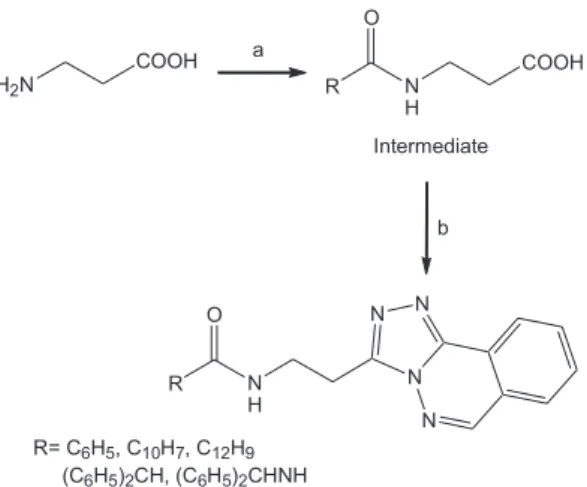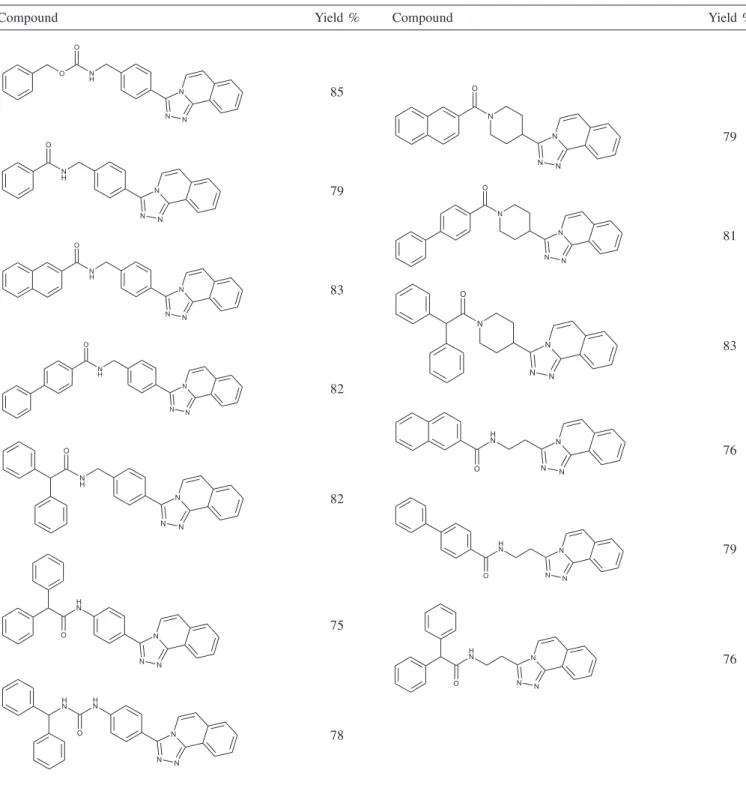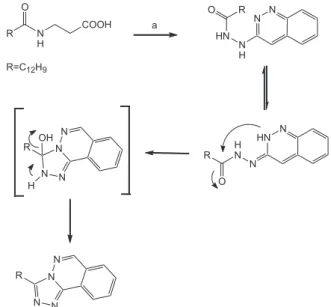Quim. Nova, Vol. 31, No. 3, 536-538, 2008
Artigo
*e-mail: girivera@uat.edu.mx
AN EASY AND DIRECT METHOD FOR THE SYNTHESIS OF 1,2,4-TRIAZOLE DERIVATIVES THROUGH CARBOXYLIC ACIDS AND HYDRAZINOPHTHALAZINE
Gildardo Rivera* and Virgilio Bocanegra-Garcia
Departamento de Farmacia y Química Medicinal, Universidad Autónoma de Tamaulipas. C/16 y Lago de Chapala, s/n, 88740, Reynosa, México
Antonio Moreno, Silvia Galiano, Silvia Pérez, Ignacio Aldana and Antonio Monge
Centro de Investigación en Farmacobiología Aplicada, Universidad de Navarra. C/Irunlarrea, s/n, 31008, Pamplona, España
Recebido em 5/2/07; aceito em 20/9/07; publicado na web em 10/3/08
We have developed an easy method for the synthesis of thirteen compounds derived from 1,2,4-triazoles through a carboxylic acid and hydrazinophthalazine reaction, with a 75-85% yield mediated by the use of agents such as 1-ethyl-3-(3´-dimethylaminopropyl)-carbodiimide hydrochloride and 1-hydroxybenzotriazole. The operational simplicity of this method and the good yield of products make it valuable for the synthesis of new compounds with pharmacological activity.
Keywords: 1,2,4-triazoles; carboxylic acids; hydrazinophthalazine.
INTRODUCTION
Triazoles constitute an important class of biologically active heterocyclic compounds that have received a great deal of attention since their discovery. Diverse compounds derived from 1,2,4-triazoles have a wide spectrum activities including antibacterial, antifungal, antiviral, antiinflammatory, antihypertensive, and hypoglycemic properties.1,2
Enders and co-workers developed the synthesis of triazole salts by amine reaction with oxadiazolium salt by condensation of N, N ´-diformylhydrazine.3 Triazole rings are typically synthesized by a process that represents a dehydrated condensation between hydrazides and nitrile derivatives. These procedures are carried out at high temperatures and depend on a stage derived from nitrile and a subsequent stage for the synthesis of acylamidrazone intermediate prior cyclization.4 Additionally, the compounds derived from 1,2,4-triazoles have been prepared using several published methods of synthesis. Each of these procedures are unsatisfactory for several reasons, but mainly because they frequently involve reactions at high temperatures with long reaction times and result in low yields. 4-8 Additionally, most of the methods for obtaining of 1,2,4-triazole
derivatives are based on heterocyclic hydrazide precursors. However, these methods have certain restrictions such as their applicability and the use of toxic reagents such as lead tetraacetate, bromine or phosphorus oxychloride.5,9-11
EXPERIMENTAL
Initially, a solution of carbonyl chloride derivative (3 equiv.) in the minimum amount of CHCl3 was added, alternately and portionwise, to a solution of the corresponding carboxylic acid (1 equiv.) in 2M NaOH (200 mL), stirring for 30 min. After the addition of NaOH, the mixture was stirred at room temperature for 48 h. The aqueous layer was acidified with concentrated HCl to pH 1-2. The residue obtained was filtered and washed with H2O and n-hexane in order to obtain carboxylic acid derivative (intermediate). The intermediate (1 equiv.), in dry CH2Cl2 (150
mL) at 0 oC in an N
2 atmosphere, was treated with 1-ethyl-3-(3´-dimethylaminopropyl)-carbodiimide hydrochloride (EDC) (1.1 equiv.) and 1-hydroxybenzotriazol (HOBT) (1.1 equiv). After 1 h at 0 oC, the corresponding hydrazinophthalazine hydrochloride (1.1 equiv.) and triethylamine (1.1 equiv.) in dry CH2Cl2 (10 mL) were added (Figure 1). The reaction was stirred at room temperature for 24 h. The solvent was evaporated and the residue was taken up with H2O and diethyl ether in order to obtain several 1,2,4 triazole derivatives (Table 1). The compounds were purified by means of recrystallization with i:PrOH or by column chromatography (CH2Cl2-CH2Cl2:MeOH).
RESULTS AND DISCUSSION
537 An easy and direct method for the synthesis of 1,2,4-triazole derivatives
Vol. 31, No. 3
The yield of this procedure is strongly affected by reactions conditions, for example, changing solvents (CH2Cl2, MeOH, EtOH, CH2Cl2:MeOH and CH2Cl2:EtOH), anhydrous conditions and temperatures that exceeded 10 oC had a dramatic effect on the rate of the reaction. Dichloromethane verified significantly better results in yield. A series of 13 compounds were obtained and confirmed by elemental analysis, IR and 1H NMR, with yield between 75 to 85% (Table 1).
Initially, we based our procedure on the reaction for obtaining carbohydrazides.12 We were pleasantly surprised to find that 1,2,4-triazole derivatives were produced using hydrazinophthalazine
hydrochloride. However, the use of different hydralazine derivatives such as 2-hydrazinopiridine, 2-hydrazino-4(trifluoromethyl) pyrimidine and 3-chloro-6-hydrazinopyridazine in the acylation of the carboxylic group did not produce 1,2,4-triazole derivatives. According to the literature, Pomarnacka and Kozlarska-Kedra used a benzodithiazine with semicarbazide hydrochloride in methanol at reflux for 30 h and aqueous sodium hydroxide at 95 ºC for the synthesis of 1,2,4-triazoles (Figure 2). They assumed that the presence of an electron-withdrawing aromatic substituent at the N-4 nitrogen atom of the semicarbazide moiety is necessary for the synthesis of the triazole ring.13
Using our experimental settings, the 4-phenylsemicarbazide
Table 1. New compounds derivatives of 1,2,4-triazoles
Compound Yield % Compound Yield %
85
79
83
82
82
75
78
79
81
83
76
79
538 Rivera et al. Quim. Nova
reaction, along with a 3-[(biphenyl-4-ylcarbonyl)amino]propionic acid reaction was carried out without resulting in a triazole derivative as Pomarnacka and Kozlarska-Kedra indicated (Figure 3). However, because we used different reaction conditions, the formation of 1,2,4-triazole derivatives may depend on other factors besides the ones proposed by Pomarnacka and Kozlarska-Kedra.
Considering the above we propose a possible mechanism in figure 4 for the formation of 1,2,4-triazole derivatives that implies the participation of the corresponding tautomerism in the molecules involved with the expected intramolecular cyclization, producing the 1,2,4-triazole derivatives.
CONCLUSION
In conclusion, we found an easy method for the synthesis of compounds derived from 1,2,4-triazoles with good performance through the use of agents such as EDC and HOBT. The operational
simplicity of this method and the good yield of the products make it valuable. Additionally, this reaction eliminates the use of toxic reagents such as lead tetraacetate or phosphorus oxychloride with each reaction. We propose a procedure that can be used in the synthesis of new compounds with pharmacological activity.
ACKNOWLEDGMENTS
The authors wish to acknowledge F. G. Espinosa, M. de la G. Barboza and O. B. Cervantes of the UAM-Reynosa Aztlán for their helpful discussions and suggestions regarding the manuscript. We would like to express our gratitude to the “Universidad Autonoma de Tamaulipas” for financial support.
REFERENCES
1. Dumaitre, B.; Dodic, N.; J. Med. Chem. 1996, 39,1635.
2. Shankar, U. R.; Jain, S.; Sinha, N.; Kishore, N.; Chandra, R.; Arora, S. K.; Eur. J. Med. Chem. 2004, 39, 579.
3. Enders, D.; Gielen, H.; Runsink, J.; Breuer, K.; Brode, S.; Boehn, K.; Eur. J. Inorg. Chem. 1998, 913.
4. Kap-Sun, Y.; Farkas, M. E.; Kadow, J. F.; Meanwell, N. A.; Tetrahedron Lett. 2005, 46, 3429.
5. Ciesielski, M.; Pufky, D.; Doring, M.; Tetrahedron2005, 61, 5942. 6. Turan-Zitouni, G.; Asim-Kaplanciki, Z.; Taha-Yildiz, M.; Chevallet, P.;
Kaya, D.; Eur. J. Med. Chem.2005, 40, 607.
7. Hewawasam, P.; Erway, M.; Thalody, G.; Wiener, H.; Boissard, C. G.; Gribkoff, V. K.; Meanwell, N. A.; Lodge, N.; Starret, J. E,; Bioorg. Med. Chem.Lett.2002, 12, 1117.
8. Navidpour, L.; Shafaroodi, H.; Abdi, K.; Amini, M.; Ghahremani, M. H.; Reza-Dehpour, A.; Shafiee, A.; Bioorg. Med. Chem. Lett.2006, 14, 2507. 9. Jagerovic, N.; Hernandez-Folgado, L.; Alkorta, I.; Goya, P.; Martin, M. I.;
Dannert, M. T.; Alsasua, A.; Frigola, J.; Cuberes, M. R.; Dordal, A.; Holenz, J.; Eur. J. Med. Chem. 2006, 41, 114.
10. Paulvannan, K.; Chen, T.; Hale, R.; Tetrahedron2000, 56, 8071. 11. Chen, C.; Dagnino, R.; Huang, C. Q.; McCarthy, J. R.; Grigoriadis, D. E.;
Bioorg. Med. Chem. Lett.2001, 11, 3165.
12. Moreno, A.; Perez, S.; Galiano, S.; Juanenea, L.; Erviti, O.; Frigola, C.; Aldana, I.; Monge, A.; Eur. J. Med. Chem. 2004, 39, 49.
13. Pomarnacka, E.; Kozlarska-Kedra, I.; Farmaco2003, 58, 423. Figure 2. Procedure that described Pomarnacka and Kozlarska-Kedra for
the synthesis of 1,2,4-triazole derivatives. Reagents and conditions: (a) semicarbazide hydrochloride, MeOH, reflux 30 h; (b) NaOH/H2O 95 ºC, 1 h
Figure 3. Carboxylic acid derivative with 4-phenylsemicarbazide reaction was carried out without resulting in 1,2,4-triazole derivatives. Reagents and conditions: (a) 4-phenylsemicarbazide, EDC, HBOT, N2, CH2Cl2


